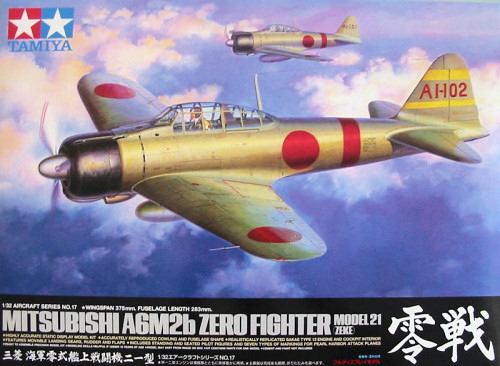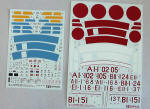
| KIT: | Tamiya 1/32 A6M2 Zero |
| KIT #: | ? |
| PRICE: | 8,000 yen at www.hlj.com |
| DECALS: | Six options |
| REVIEWER: | Tom Cleaver |
| NOTES: |

| HISTORY |
At the time of its appearance in combat over China inSeptember 1940, the Mitsubishi A6M2 "Zero" was arguably the most advanced single‑seat single‑engine fighter in the world. That it was designed to fly from aircraft carriers made it even more amazing. Its heavy armament of 2 20mm canon and 2 7.72mm machine guns was only equaled by the Messerschmitt Bf‑109E. There was not a contemporary fighter in the world it could not fly rings around in combat. Even more remarkable was its range, which was at least four times as great as any of its contemporaries; at the outset of the Pacific War its opponents would end up crediting the Imperial Japanese Navy with more aircraft carriers than they had, since it was inconceivable that a fighter could fly from Formosa to the Philippines and have time for 45 minutes of combat before returning ‑ which the Zero accomplished regularly. When the U.S. invaded Guadalcanal, the Japanese would regularly send Zeros from Rabaul to the battle front, a distance of 600 miles one way, over water all the way, until new bases could be constructed at Bougainville.
The Zero paid for this spectacular performance with a very light structure that foreswore both defensive armor and self‑ sealing fuel tanks, since its engine was no more powerful than any of its contemporaries, being a Sakae‑11 of 1,200 horsepower.
Its maneuverability above 250 m.p.h. was seriously degraded by stiff ailerons, and at over 300 m.p.h. its maneuverability advantage was largely negated. Almost any Allied fighter, by the fact of the additional weight of armor and self‑sealing fuel tanks, could dive away from a fight with a Zero if need be. With such a light structure, one good burst from the American armament of six .50 caliber machine guns would explode a Zero if the pilot could hold the Zero in his sights long enough.
During the first year of the Pacific War, the myth of the Zero was considerably enhanced by the fact that it was flown by pilots who were among the best in the world ‑ the pre‑war trained fighters of the Imperial Japanese Navy ‑ who not only averaged some 800 flying hours as compared with half that much or less for their opponents, but could count significant time and experience in actual combat over China during the Sino‑Japanese conflict that had raged since 1937.
Unfortunately for the Japanese, the A6M2 Model 21 ‑ the first Zero to see combat in significant numbers ‑ was also the best of the series. Successive changes did not improve performance significantly as compared with the increased performance of the new Allied types that entered combat beginning in late 1942 with the arrival of the P‑38 Lightning in New Guinea. Coupled with new tactics that played to the strengths of the Allied fighters and against the weaknesses of the Zero that were discovered when an A6M2 that crashed in the Aleutians was flight tested, and the fact that the Japanese were unable to replace their pilot losses after Midway and Guadalcanal with similarly‑trained personnel, and the day of the Zero was basically over by the conclusion of the Guadalcanal campaign.
| THE KIT |

 Tomy
previously released an A6M2 Model 21 Zero in 1/32 scale during the late 1970s.
While this was a very nice kit, it has become dated. Once Tamiya released their
A6M5 Model 52 Zero in late 2000, it was only a matter of time before they would
release the “classic” Zero, the A6M2b, Model 21.
Tomy
previously released an A6M2 Model 21 Zero in 1/32 scale during the late 1970s.
While this was a very nice kit, it has become dated. Once Tamiya released their
A6M5 Model 52 Zero in late 2000, it was only a matter of time before they would
release the “classic” Zero, the A6M2b, Model 21.
Produced to the same high standard as the previous Zero kit, this Tamiya Zero
can be considered “definitive.” It has operating features like retractable
landing gear that also has “bounce” in the oleos, while the rudder and the flaps
can be posed open or closed and moved back and forth. The wingtips can be shown
either folded or extended. (I've shown only two representative sprue shots so
you can get a general idea of the complexity of the kit. The rest of the parts
are very much like the A6M5 kit of a few years back. Ed)
Decals are provided for six different Zeros flown in the Pearl Harbor attack, one from each of the six carriers that participated in the opening move of the Pacific War. Experts have already pointed out that the decals provided for Lt. Iida’s Zero from the “Soryu” has the light blue that was used after mid-February 1942, rather than the “Blue Angel Blue” used for the Pearl Harbor attack. Other than this, everything else about the kit has passed muster with the experts.
| CONCLUSIONS |
I could not help getting the feeling as I opened this big box and examined what was inside, that I had seen this kit before, and not that long ago. As I examined the surface detail, with its engraved rivets, it struck me: this kit is at the same quality and detail level as the Trumpeter SBD Dauntless. In fact, if the box and the instructions said “Trumpeter”, no one would ever think it came from Tamiya.
I don’t say that as a bad thing. Trumpeter has “made their bones” with the TBF Avenger, the Me-262 and now the SBD Dauntless. There’s an old saying that “imitation is the sincerest form of flattery,” and this kit from Tamiya clearly demonstrates they are aware of the powerhouse across the Yellow Sea.
The model looks overall excellent. My one and only complaint is that providing the seatbelts as “stickers” in this scale is pretty chintzy. But I’ll be using the Cutting Edge 1/32 posable resin seatbelts anyway, so it doesn’t really matter that much.
Thanks to HobbyLink Japan for the review kit. Get yours at “Japanese prices”from www.hlj.com
June 2006
If you would like your product reviewed fairly and quickly by a site that has over 300,000 visitors a month, please contact me or see other details in the Note to Contributors.